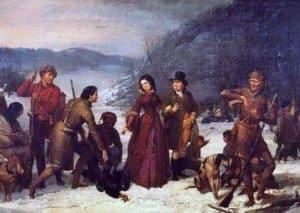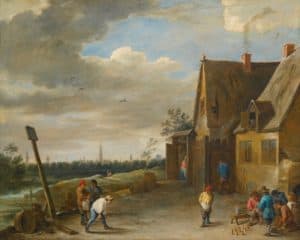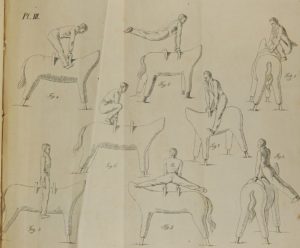Come Out and Play: Sports in America Before 1860
By John Marks, Curator of Collections and Exhibits
In June we’ll continue our 2019 sports theme with the exhibit, “Come Out and Play: Sports in Geneva.” This will cover all sports outside of the school and college settings. As we research and write this exhibit, we ponder several questions. What’s a sport versus game, recreation, or play? Does it matter, if the participants like it? Have the definitions changed over time? As we consider all these, we begin with American sports history.
In colonial America, games were usually associated with childhood. Strict Christians expected games to be cast off as one grew up, in keeping with I Cornithians in the Bible: “When I became a man, I put away childish things.” Into the 1800s they favored “rational amusements” like lectures or introspective walks in nature.

The Turkey Shoot, by T.H. Matteson, 1857
Not everyone shared these views. In the late 1700s, popular American sports included horse racing, shooting, and quoits. I’ve never been convinced that horse racing is a sport, at least not for humans. Shooting for defense and hunting was an important skill. Events like target shooting for prizes honed that skill. Quoits involved throwing metal rings onto a stake, and is still played today.

Peasants playing nine-pins outside an inn, by David Teniers the Younger, ca. 1640
Immigrants brought their games with them. Quoits, cricket, and rounders (baseball’s nearest ancestor) came from England. The Dutch played nine-pins, which with the addition of one more pin became American bowling. Scottish immigrants brought their field games of running, jumping, and throwing heavy objects.
By the early 1800s in Europe, the gymnastics movement promoted the benefits of daily exercise. Its “strong body, strong mind” principles are the basis of modern physical fitness. Friedrich Jahn (1778 – 1852) was a German gymnastics educator who began the Turner movement. When Germans moved to America in large numbers after 1848, they founded turnvereins, or gymnastic clubs. There is still an active Turner club in Syracuse.

Illustration from A Treatise on Gymnastics, by Friedrich Jahn, 1828
Europeans didn’t have a monopoly on promoting exercise. Born into a family of clergy and reformers, Catharine Beecher (1800-1878) devoted her life to female education. She believed physical fitness was important, and in 1831 wrote Course of Calisthenics for Young Ladies.
Sports didn’t become widespread until after the Civil War, and that’s where I’ll pick up the story in June.
